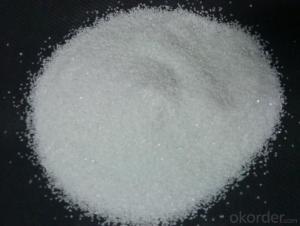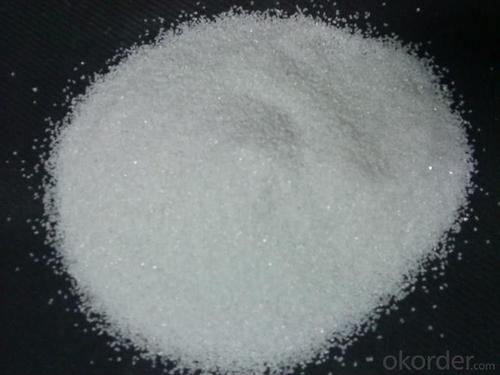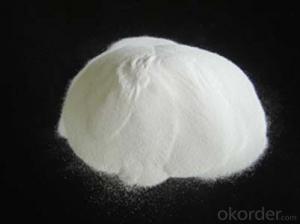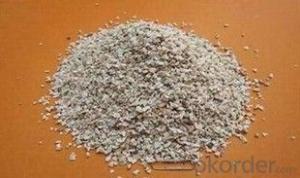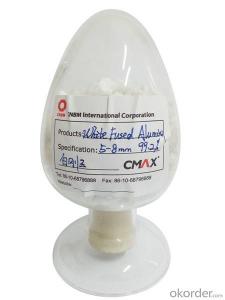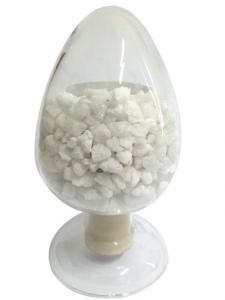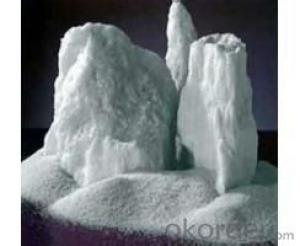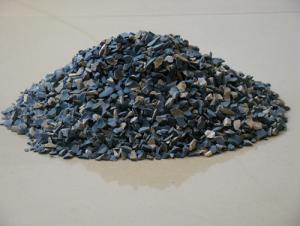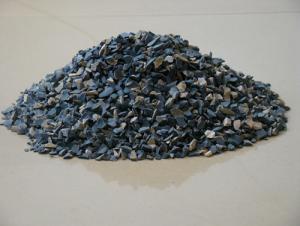Raw Materials for Refractory - White Fused Alumina Materials
- Loading Port:
- Tianjin
- Payment Terms:
- TT OR LC
- Min Order Qty:
- 20 m.t.
- Supply Capability:
- 1000 m.t./month
OKorder Service Pledge
OKorder Financial Service
You Might Also Like
Aggregate for high-quality refractory materials (shaped and non-shaped) for the steel, foundry , and glass industry.
Meanwhile, WFA could be used for Ceramic field
Size: 0-1mm, 1-3mm, 3-5mm.... such phase sand
0-10mm; 0-30mm................such block sand
220mesh, 325mesh............such fine powder
Specification
Al2O3 Fe2O3 SiO2 Na2O B.D.
99.2%Min 0.1% Max 0.2% Max 0.3% Max 3.7g/cm3 Min
In the same condition, using manganese or silicon to deoxidize separately, the burn out rate are 46% and 37%, but it is only 29% if using manganese alloy to deoxidize. So, it is used widely to smelting steel and its output increases faster than ferroalloy's, so has become an indispensable composite deoxidizing and alloy additives in steel industry. The silicon-manganese which contains carbon below 1.9% still is used to produce medium/low-carbon ferromanganese and semi-finished products of electro silicothermic process manganese metal.
- Q: Why the refractories should be waterproof and wetproof
- The binding agent of many raw materials is water-soluble. It will be useless when meeting water.
- Q: What is the strength of high strength refractory material?
- Refers to constrcuting through ramming, and a refractory materials that is hardened in temperature higher than normal. mixed through a certain grade of refractory aggregate, powder, binder, additives, water or other liquids. Can be classified into high alumina and fireclay, magnesite, dolomite, zirconium and silicon carbide by the standard of texture.
- Q: which kind of material should be used in fireproofing cabinet?
- Cabinet fireproof?panel can be divided into fiber cement fireproofing board, metal fireproof?panel, mineral wool fireproof?panel, perlite fireproof?panel and many other fireproof?panels. Wherein fiber cement fireproofing board is a new material with growing popularity , it has good thermal insulation and sound insulation performance and belongs to a1 level fireproofing material. Fiber cement fireproofing board is a kind of decoration sheet that takes silicious material or calcareous material as the main raw materials and is made by being combined with fibrous material and other additives in certain proportion. Metal fireproof?panel is a kind of sandwich dalle that takes aluminium plate, stainless steel plate, colorful steel plate and other metal materials as main raw materials and is made by adding some fire?retardant materials. Mineral wool board is a kind of fireproofing decorative board that takes mineral wool and glass wool as the main raw materials. Perlite fireproof panel is a kind of fireproofing hollow plate that take low alkalinity cement as the main materials and fireproofing perlite as filler.
- Q: Who knows about the fire endurance of sintered shaly hollow bricks?
- 1. after roasting at high temperature of more than 1200 degrees, shale burned bricks in construction works can be free from expanding with heat and contracting with cold. 2. masonry walls can be plastered with no needs of any anti-cracking, reinforcement measures, and walls will not bulge and crack, which can reduce the construction cost, as well as are preferred building materials of frame structural engineering. 3.They have good sound insulation and thermal insulation performances, are one of the green building materials that the state currently promotes. 4. They have high intensity. The average compressive strength of them is up to 15.8, which matches with M7.5 cement mortar that has advantages of low water absorption, and good anti efflorescence performance.
- Q: Which fire-resistant materials have good viscidity?
- Viscidity is necessary for gunning mix, repair mix and bordering. It is too broad to which has good viscidity. Both gunning mix and repair mix are powder before adding water. Bordering also has little viscidity before heating. The question shoule be more specific.
- Q: Does anyone know about the A-level fireproof materials?
- rock wool external wall composite board, A1-level fire rock wool board, hidden slit rock wool board ? 30, A1-level fireproof mineral wool sound-absorbing board. What about the sound-absorbing sheet? glass fiber acoustic board engineering of the TV backdrop ? 85, A1-level fireproofing and thermal insulation rock wool board is hydrophobic thermal insulation, external wall thermal insulation materials ? 200, high temperature resistant calcium silicate board, LCFC/calcium?silicate?board is A1-level fireproof materials with high-quality and low-price ? 75, the prices above are from the internet for reference only, and the purchase prices vary according to the market.
- Q: What are the main characteristics of the sic refractories?
- The physical properties of SiC refractories include structural properties, thermal properties, mechanical properties, usability and job performance. The structural properties of refractory include porosity, bulk density, water absorption, air permeability, an the distribution of pore size. The thermal properties of refractory include thermal conductivity, thermal expansion coefficient, specific heat, heat capacity, thermal diffusivity, and thermal emission rate. The mechanical properties of refractories include withstand voltage strength, tensile strength, anti bending strength, torsional strength, shear strength, impact strength, abrasion resistance, creep resistance, adhesive strength, and elasticity modulus. The usability of refractories include refractoriness, load softening temperature, linear?change?on?reheating, thermal shock resistant performance, slag resistance, acid resistance, alkali resistance, hydration resistance, corrosion resistance to CO, conductivity, and inoxidizability.
- Q: Who knows the roofing fireproofing and waterproof material?
- Many waterproof materials are suitable for civil engineering, and almost used in the roof waterproof layer, such as: Paint categories: 911 two-component polyurethane waterproof coating single component polyurethane waterproof coating polymer cement-based waterproof coating JS composite waterproof coating and so on. . Coil categories: single-sided waterproof roll double-sided self-adhesive waterproof roll modified asphalt waterproof roll (SBS, APP) polypropylene, polyester, polymer waterproof roll, PVC waterproof roll, EPDM waterproof roll
- Q: What is the the best matching ratio of refractory cement?
- Refractory cement is very easy to use. Add some water and mix, and it will harden. Generally there is no need to add other binding agents, but you can add some refractory aggregate and powder. If you use only refractory cement, it will produce a lot of cracks after high temperature. Generally refractory cement can withstand temperature of about 1300 degrees. Refractory cement can be used together with ordinary sand, and the ratio of cement and the sand is about 30 percent.
- Q: What is the the best ratio of mortar in refractory cement?
- Specifical proportions are as following: 42.5R cement is 425 rapid hardening cement. Using the 425 cement to compound the mortar. The reducion of cement will naturally impact the workability of the mortar. The mix design standard of the mortar specifies the minimum amount of cement is not less than 200kg / m3. If it is composite mortar, and the strength and workability can be ensured, it is Ok to use 425 to compound. You can look for instructions of mixing proportion of mortar online as a reference.
Send your message to us
Raw Materials for Refractory - White Fused Alumina Materials
- Loading Port:
- Tianjin
- Payment Terms:
- TT OR LC
- Min Order Qty:
- 20 m.t.
- Supply Capability:
- 1000 m.t./month
OKorder Service Pledge
OKorder Financial Service
Similar products
Hot products
Hot Searches
Related keywords
